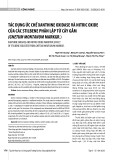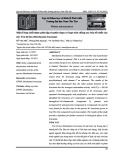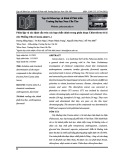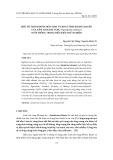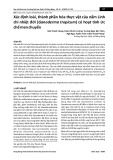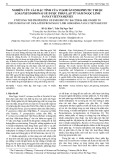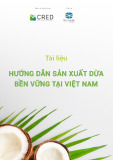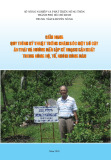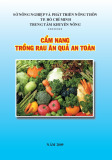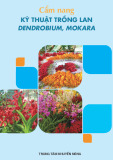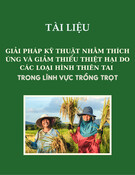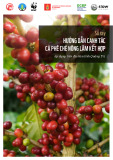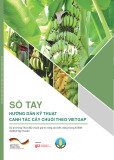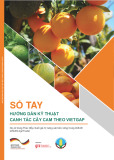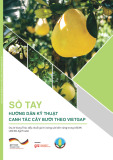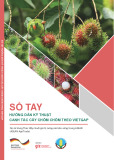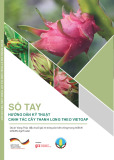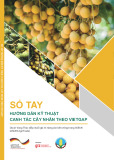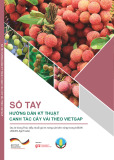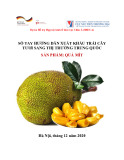
VNU Journal of Science: Natural Sciences and Technology, Vol. 41, No. 1 (2025) 81-88
81
Original Article
Inhibitory Effects of Microalgal Biofilm
on Vibrio parahaemolyticus
Pham Thi Luong Hang1,2,*, Tran Van Thang2, Truong Quynh Chi2,
Ngo Thi Trang2, Le Van Nhat Anh1, Le Van Khoa3
1HUS High School for Gifted Students, VNU University of Science,
182 Luong The Vinh, Thanh Xuan, Hanoi, Vietnam
2VNU University of Science, 334 Nguyen Trai, Thanh Xuan, Hanoi, Vietnam
3Vietnam National University of Agriculture, Trau Quy, Gia Lam, Hanoi, Vienam
Received 05th June 2024
Revised 24th October 2024; Accepted 04th November 2024
Abstract: Microalgae are primary producers, the first trophic level in the food webs of aquatic
ecosystems. Therefore, they have many potential applications in aquaculture. This study aimed to
create autotrophic biofilms from microalgae strains belonging to the Nostocaceae,
Protosiphonaceae, and Scenedesmaceae, isolated in Vietnam and to select a microalgal biofilm
capable of inhibiting Vibrio parahaemolyticus. The microalgal biofilms were created by attaching
the microalgal strains (cyanobacterium and green algae) to substrates (coconut fibre, sugarcane
bagasse and cheesecloth). Additionally, the inhibitory effect of the microalgal biofilm on
V. parahaemolyticus was evaluated based on the reduction proportion of V. parahaemolyticus cell
numbers in an environment with the microalgal biofilm (co-culture method) compared to those in
an environment without microalgal biofilm. The results showed that coconut fibre and cheesecloth
had higher coverage density and biomass content of microalgae after 72 hours of biofilm formation
than the sugarcane bagasse. We also found that microalgal biofilms formed by the combination
of a cyanobacterial strain NK1111 with a green microalgal strain MBN1 or MHN122 reduced
76.2% - 99.8% of V. parahaemolyticus in 96 - 120 hours of co-culture. Meanwhile, microalgal
biofilm formed by the strain NK1111 and a green microalgal strain MHB231 inhibited 91.8% of
V. parahaemolyticus bacterium as early as 24 hours and inhibited 99.4% of this bacteria at 120
hours of co-culture. Therefore, the microalgal biofilms consisting of the strain NK1111 and the
strain MHB231 on cheesecloth or coconut fibre substrate are highly appreciated for their potential
application in shrimp farms in Vietnam.
Keywords: Autotrophic biofilm, Antibacterial activity, Cyanobacteria, Co-culture method,
Microalgae, Vibrio parahaemolyticus.
D*
_______
* Corresponding author.
E-mail address: luonghang@hus.edu.vn
https://doi.org/10.25073/2588-1140/vnunst.5751

P. T. L. Hang et al. / VNU Journal of Science: Natural Sciences and Technology, Vol. 41, No. 1 (2025) 81-88
82
Tác dụng ức chế của màng vi tảo
đối với vi khuẩn Vibrio parahaemolyticus
Phạm Thị Lương Hằng1,2,*, Trần Văn Thắng2, Trương Quỳnh Chi2,
Ngô Thị Trang2, Lê Văn Nhật Anh1, Lê Văn Khoa3
1Trường Trung học phổ thông chuyên Khoa học Tự nhiên, Trường Đại học Khoa học Tự nhiên,
Đại học Quốc gia Hà Nội, 182 Lương Thế Vinh, Thanh Xuân, Hà Nội, Việt Nam
2Trường Đại học Khoa học Tự nhiên, Đại học Quốc gia Hà Nội,
334 Nguyễn Trãi, Thanh Xuân, Hà Nội, Việt Nam
3Học viện Nông nghiệp Việt Nam, Trâu Quỳ, Gia Lâm, Hà Nội, Việt Nam
Nhận ngày 05 tháng 6 năm 2024
Chỉnh sửa ngày 24 tháng 10 năm 2024; Chấp nhận đăng ngày 04 tháng 11 năm 2024
Tóm tắt: Vi tảo là nhóm sinh vật sản xuất, là mắt xích đầu tiên trong các lưới thức ăn của các hệ
sinh thái thủy vực. Vì vậy, chúng có nhiều tiềm năng ứng dụng trong lĩnh vực nuôi trồng thủy sản.
Mục tiêu của nghiên cứu này là tạo ra được các màng sinh học tự dưỡng từ các chủng vi tảo thuộc
các họ Nostocaceae, Protosiphonaceae và Scenedesmaceae phân lập tại Việt Nam và lựa chọn
được một loại màng có khả năng ức chế vi khuẩn Vibrio parahaemolyticus. Màng vi tảo được tạo
ra bằng cách gắn các chủng vi tảo (vi khuẩn lam và vi tảo lục) lên các vật liệu (xơ dừa, bã mía
hoặc vải thưa); đồng thời, khả năng ức chế của màng vi tảo đối với V. parahaemolyticus được
đánh giá dựa vào sự giảm số lượng tế bào V. parahaemolyticus trong môi trường có màng vi tảo
(phương pháp cùng nuôi) so với trong môi trường không có màng vi tảo. Kết quả cho thấy, vật liệu
xơ dừa và vải thưa có mật độ bao phủ và chứa hàm lượng sinh khối vi tảo, sau 72 giờ tạo màng,
cao hơn vật liệu bã mía. Bên cạnh đó, màng vi tảo được hình thành bởi tổ hợp của chủng vi khuẩn
lam NK1111 với chủng vi tảo lục MBN1 hoặc MHN122 có khả năng ức chế 76,2% - 99,8% khuẩn
V. parahaemolyticus trong khoảng thời gian từ 96 giờ đến 120 giờ thử nghiệm. Trong khi đó,
màng vi tảo được hình thành từ chủng vi khuẩn lam NK1111 và chủng vi tảo lục MHB231 có khả
năng ức chế 91,8% vi khuẩn V. parahaemolyticus ngay từ thời điểm 24 giờ và ức chế 99,4% vi
khuẩn này ở thời điểm 120 giờ thử nghiệm. Chính vì vậy, màng vi tảo NK1111 + MHB231 trên
hai loại giá thể vải thưa hoặc giá thể xơ dừa được đánh giá là có tiềm năng ứng dụng cao trong các
trang trại nuôi tôm ở Việt Nam.
Từ khóa: Màng sinh học tự dưỡng, Phương pháp cùng nuôi cấy, Ức chế vi khuẩn, Vibrio
parahaemolyticus, Vi khuẩn lam, Vi tảo.
1. Mở đầu *
Vi tảo là nhóm sinh quang tự dưỡng được
đánh giá là có năng suất sinh học lớn nhất trong
sinh giới [1]. Sinh khối của vi tảo có chứa các
loại amino acid thiết yếu, các dạng lipid có lợi,
carbohydrate, cùng đầy đủ các vitamin và sắc tố
_______
* Tác giả liên hệ.
Địa chỉ email: luonghang@hus.edu.vn
https://doi.org/10.25073/2588-1140/vnunst.5751
[2]. Chính vì thế, vi tảo được coi là một nguồn
thức ăn có hàm lượng dinh dưỡng cao lại an
toàn cho con người và các động vật thủy sản
(cá, tôm,…) [3]. Do có khả năng sinh trưởng
nhanh trong các môi trường nước mặn, nước lợ
và nước ngọt nên chúng trở thành một nguồn
dinh dưỡng thường xuyên, không bao giờ cạn
kiệt ngay trong môi trường sống của các động
vật thủy sản. Bên cạnh vai trò là nguồn thức ăn,
nhiều nghiên cứu còn chứng minh vi tảo có khả
năng làm sạch nước nuôi bằng cách loại bỏ 74,8

P. T. L. Hang et al. / VNU Journal of Science: Natural Sciences and Technology, Vol. 41, No. 1 (2025) 81-88
83
- 86,1% nitrogen tổng và 82,7% - 92,2%
phospho tổng trong nước thải của ao nuôi tôm
[3, 4], đồng thời chúng có khả năng ức chế sinh
trưởng của các vi khuẩn V. parahaemolyticus,
V. alginolyticus, V. lentus, V. alginolyticus,…
gây bệnh trong nuôi trồng thủy sản [5]. Vi tảo
có khả năng ức chế vi khuẩn gây bệnh thuỷ sản
khi sử dụng ở dạng tế bào sống hoặc ở dạng
dịch chiết [6]. Chính vì thế, vi tảo được sử dụng
như một nhóm vi sinh vật có lợi làm tác nhân
kiểm soát cân bằng sinh học, ức chế các vi sinh
vật gây bệnh trong các hồ nuôi [7].
V. parahaemolyticus là loài vi khuẩn xuất
hiện phổ biến trong các ao/hồ nuôi tôm, và là
tác nhân gây bệnh hoại tử gan tụy cấp ở tôm
[8]. Vì vậy, V. parahaemolyticus được coi là
sinh vật đích cho các nghiên cứu đánh giá khả
năng ức chế bởi các vi tảo lục như Tetraselmis
suecica, Isochrysis galbana, Skeletonema
costatum, Dunaliella tertiolecta,… [2, 9].
Trong một nghiên cứu trước, chúng tôi cũng đã
phát hiện được chủng vi khuẩn lam NK1111 có
khả năng sản sinh hợp chất ức chế vi khuẩn
V. parahaemolyticus, đồng thời chủng này cũng
làm giảm 94,0% - 95,6% nồng độ của vi khuẩn
V. parahaemolyticus sau 72 - 96 giờ cùng nuôi
[10]. Trong nghiên cứu này, chúng tôi tiếp tục
phát triển một cấu trúc màng sinh học tự dưỡng
được hình thành từ chủng vi khuẩn lam
NK1111 với các chủng vi tảo lục có giá trị dinh
dưỡng cao (28,5% - 29,4% protein, 15,5% -
20,7% carbohydrate, 12,0% - 25,0% lipd - số
liệu chưa công bố) nhằm mục đích phát huy
tiềm năng ức chế vi khuẩn V. parahaemolyticus
bởi các chủng vi tảo. Các chủng vi tảo sử dụng
trong nghiên cứu đều có nguồn gốc từ các thủy
vực ở Việt Nam, do đó, màng vi tảo có thể dễ
dàng thích nghi và phát triển trong các ao/hồ
nuôi tôm, đem lại lợi ích cho ngành nuôi trồng
thủy sản nội địa.
2. Nguyên liệu và phương pháp nghiên cứu
2.1. Các chủng vi sinh vật sử dụng trong nghiên cứu
Vibrio parahaemolyticus ATCC 17802 được
đặt từ hãng ThermoFisher Scientific (Hoa Kỳ) và
được nuôi trong môi trường Thiosulfate Citrate
Bile Salts Sucrose (TCBS - Merck, Đức) hoặc
môi trường Luria-Bertani (LB-ThermoFisher
Scientific, Hoa Kỳ) chứa NaCl 3%. Trong
nghiên cứu này chúng tôi sử dụng một chủng vi
khuẩn lam (NK1111) và ba chủng vi tảo lục
(MHN122, MBN1 và MHB231) để tạo màng
sinh học tự dưỡng (màng vi tảo). Hình thái của
của bốn chủng vi tảo trong nghiên cứu được thể
hiện ở Hình 1. Trong đó, chủng vi khuẩn lam
NK1111 thuộc họ Nostocaceae Eichler [11],
chủng vi tảo lục MHN122 thuộc họ
Protosiphonaceae Blackman & Tansley [11],
hai chủng MBN1 và MHB231 cùng thuộc họ
Scenedesmaceae Oltmanns [11]. Bốn chủng vi
tảo này được phân lập từ đất ruộng ở Bắc Ninh,
Hà Nội và Hòa Bình và được lưu giữ trong môi
trường dinh dưỡng Blue – Green medium
(BG11) tại phòng thí nghiệm Bộ môn Chuyên
Sinh, Trường Trung học phổ thông Chuyên
Khoa học Tự nhiên, Trường Đại học Khoa học
Tự nhiên, Đại học Quốc Gia Hà Nội.
2.2. Phương pháp tạo màng vi tảo
Ba loại vật liệu dễ phân huỷ là vải thưa, xơ
dừa và bã mía được sử dụng để làm giá thể cho
vi tảo. Mỗi loại vật liệu được rửa sạch, hấp vô
trùng và cắt thành miếng vuông có kích thước
2,0 cm2, độ dày 1,0 - 2,0 mm và được ghi lại
khối lượng của mỗi loại giá thể sau khi sấy khô.
Quá trình tạo màng vi tảo được tiến hành theo
hai giai đoạn, giai đoạn tạo biofilm cấp 1 trong
3 ngày đầu (chỉ có chủng vi khuẩn lam NK1111
bám vào bề mặt vật liệu) và giai đoạn tạo
biofilm cấp 2 trong 3 ngày tiếp theo (có thêm sự
bám dính của một trong ba chủng vi tảo lục
MBN1, MHN122 hoặc MHB231). Mỗi loại
màng vi tảo được hình thành từ sự kết hợp của
chủng vi khuẩn lam (NK1111) với một chủng
vi tảo lục (MBN1 hoặc MHB231 hoặc
MHN122) trên một loại giá thể (vải thưa hoặc
xơ dừa hoặc bã mía). Vì vậy, chín loại màng
sinh học đã được tạo ra từ tổ hợp của chủng vi
khuẩn lam NK1111 với ba chủng vi tảo lục
(MHN122/MBN1/MHB231) trên ba loại giá thể
khác nhau. Khả năng tạo màng sinh học tự
dưỡng bởi sự kết hợp của hai chủng vi tảo và
sinh khối khô của màng vi tảo được ghi nhận
sau 6 ngày thí nghiệm.
f

P. T. L. Hang et al. / VNU Journal of Science: Natural Sciences and Technology, Vol. 41, No. 1 (2025) 81-88
84
Hình 1. Hình thái của bốn chủng vi tảo trong nghiên cứu.
2.3. Đánh giá khả năng ức chế sinh trưởng của
màng vi tảo đối với V. parahaemolyticus
Phương pháp đánh giá khả năng ức chế
sinh trưởng của màng vi tảo đối với
V. parahaemolyticus được thực hiện theo công
bố của Nguyễn Văn Kiên và cộng sự [10] với
một cải tiến nhỏ. Trong đó, màng sinh học tự
dưỡng chứa chủng vi khuẩn lam NK1111 và
một trong 3 chủng vi tảo lục (MBN1 hoặc
MHN122 hoặc MHB231) được sử dụng thay
thế 5 mL cặn sinh khối tươi của chủng NK1111
(đã ly tâm để loại dịch nuôi cấy). Mỗi tổ hợp
màng vi tảo của chủng NK1111 với một chủng vi
tảo lục được bố trí thành 6 lô thí nghiệm như sau:
Nghiệm thức 1-XD: 45 mL BG11 NaCl 3%
+ 2,5 mL LB NaCl 3% + V. parahaemolyticus
(104 CFU/mL) + 10 màng vi tảo trên giá thể
xơ dừa.
Nghiệm thức 2-XD: 45 mL BG11 NaCl 3%
+ 2,5 mL LB NaCl 3% + V. parahaemolyticus
(104 CFU/mL) + 10 giá thể xơ dừa.
Nghiệm thức 3-XD: 45 mL BG11 NaCl 3%
+ 2,5 mL LB NaCl 3% l + 10 màng vi tảo trên
giá xơ dừa.
Nghiệm thức 1-VT: 45 mL BG11 NaCl 3%
+ 2,5 mL LB NaCl 3% + V. parahaemolyticus
(104 CFU/mL) + 10 màng vi tảo trên giá thể
vải thưa.
Nghiệm thức 2-VT: 45 mL BG11 NaCl 3%
+ 2,5 mL LB NaCl 3% + V. parahaemolyticus
(104 CFU/mL) + 10 giá thể vải thưa.
Nghiệm thức 3-VT: 45 mL BG11 NaCl 3%
+ 2,5 mL LB NaCl 3% + 10 màng vi tảo trên
giá thể vải thưa.
Trong đó, nồng độ vi khuẩn
V. parahaemolyticus được bổ sung vào mỗi
nghiệm thức được tính toán để tương đương với
104 CFU/mL. Thí nghiệm với mỗi loại màng
sinh học tự dưỡng được lặp lại 3 lần và tỷ lệ ức
chế sinh trưởng của V. parahaemolyticus gây ra
bởi mỗi loại màng này tại các thời điểm thu
mẫu (24 giờ, 48 giờ, 72 giờ, 96 giờ và 120 giờ)
được xác định theo công thức:
Tỷ lệ ức chế (%) = (1- CFU mẫu nghiệm
thức 1/CFU mẫu nghiệm thức 2) × 100%
2.4. Phương pháp xử lý thống kê
Số liệu thí nghiệm được xử lý thống kê
bằng phần mềm Microsoft Excel (Microsoft,
USA) phiên bản 2016, với các hàm số TTEST,
AVERAGE và STDEV.S.
3. Kết quả
3.1. Kết quả sự tạo màng vi tảo
Kết quả ghi nhận sau 6 ngày tạo màng vi tảo
cho thấy, cả ba loại giá thể đều có sự bám dính
của các chủng vi khuẩn lam và vi tảo lục từ thời
điểm 24 giờ đến 72 giờ (Hình 2). Trong đó, giá
thể xơ dừa và vải thưa có mật độ cư trú của vi tảo
nhiều hơn so với giá thể bã mía (Hình 2A). Mật
độ của hai chủng vi tảo cũng tăng lên tương
ứng từ 24 giờ đến 72 giờ khi được quan sát
dưới kính hiển vi quang học (Hình 2B). Mặt
khác, kết quả về sinh khối khô của hỗn hợp vi
khuẩn lam và vi tảo lục cũng đã chứng minh
khả năng bám dính tốt nhất của hai loại vi tảo
này là trên giá thể vải thưa, sau đó là giá thể xơ
dừa và cuối cùng là giá thể bã mía với hàm
lượng sinh khối lần lượt là 3,6 ± 0,4 mg/màng,
2,8 ± 0,6 mg/màng và 1,2 ± 0,2 mg/màng.
Hiện nay, so với việc sử dụng vi tảo ở dạng
tự do trong các lĩnh vực sản xuất thức ăn dinh
dưỡng, sản xuất nhiên liệu, loại bỏ vi sinh vật
trong nuôi trồng thủy sản và xử lý nước thải, thì
màng vi tảo được đánh giá cao hơn bởi sở hữu
nhiều đặc tính ưu việt như dễ thu hoạch, khả
năng thu hồi sinh khối cao hơn và tiêu thụ nước
ít hơn [12]. Vi tảo có ưu thế trong việc tạo
màng sinh học so với các nhóm sinh vật khác

P. T. L. Hang et al. / VNU Journal of Science: Natural Sciences and Technology, Vol. 41, No. 1 (2025) 81-88
85
do có nhiều protein và carbohydrate ở bề mặt tế
bào giúp chúng dễ dàng bám dính vào bề mặt
vật liệu mang [13]. Vật liệu được sử dụng để
làm giá thể cho vi tảo rất đa dạng có thể sử
dụng các vật liệu tự nhiên (gỗ, sợi bông, mùn
cưa) hoặc vật liệu tổng hợp (polyester, nylon)
[12]. Theo Venable và cộng sự [14] vật liệu
mang phải duy trì được sự nguyên vẹn và
không bị biến đổi bởi nhiệt độ, tia UV và hoạt
động sống của vi sinh vật.
f
Hình 2. Màng sinh học tự dưỡng được hình thành từ chủng vi khuẩn lam NK1111 và chủng vi tảo BMN1
A: Biofilm cấp 2 trên ba loại giá thể được chụp bằng camera thường ở các thời điểm 24 giờ, 48 giờ và 72 giờ;
B: Biofilm cấp 2 được hình thành trên giá thể vải thưa được quan sát dưới kính hiển vi quang học
ở các thời điểm 24 giờ, 48 giờ và 72 giờ; h: giờ.
Trong nghiên cứu này, chúng tôi đã sử dụng
ba loại vật liệu tự nhiên là vải thưa, xơ dừa và
bã mía vừa đảm bảo độ bền trong quá trình sử
dụng lại vừa có thể loại bỏ ra khỏi các ao nuôi
khi mật độ vi tảo tăng cao. Trong đó, giá thể vải
thưa và xơ dừa cho kết quả bám dính của vi tảo
nhanh hơn, thể hiện ở lượng sinh khối vi tảo từ
2,8 đến 3,6 mg/màng. Việc phát hiện xơ dừa có
thể được sử dụng làm giá thể cho vi tảo là một
sáng kiến độc đáo giúp tận dụng được nguồn
phế thải sinh hoạt hàng ngày ở Việt Nam nhưng
vẫn đảm bảo bảo được hiệu quả của việc sản
xuất màng vi tảo.
Màng vi tảo có thể được tạo ra từ một
chủng vi tảo đơn lẻ hoặc kết hợp nhiều chủng vi
tảo trên cùng một giá thể. Nghiên cứu này đã sử
dụng hai loại vi tảo khác nhau là vi khuẩn lam
và vi tảo lục nhằm tận dụng khả năng bám dính
tốt của chủng vi khuẩn lam NK1111 vào bề mặt
vật liệu do có dạng sợi dài, có bao nhày
polysaccharide và chủng vi tảo đơn bào
(MHN122 hoặc MBH231) có khả năng lấp đầy
và làm dày bề mặt giá thể sau khi có sự định cư
của chủng vi khuẩn lam.
3.2. Khả năng ức chế của màng vi tảo đối với
V. parahaemolyticus
Do khả năng bám dính tốt của các chủng vi
tảo trên hai loại giá thể vải thưa và xơ dừa so
với giá thể bã mía nên trong thí nghiệm này
chúng tôi chỉ lựa chọn các màng vi tảo hình
thành trên giá thể vải thưa và xơ dừa để đánh
giá khả năng ức chế đối với vi khuẩn
V. parahaemolyticus (sau đây gọi tắt là vi
khuẩn Vp). Số liệu về đơn vị hình thành khuẩn
lạc (CFU/mL) của vi khuẩn Vp trong các bình
nuôi có một trong ba loại màng vi tảo (NK1111
+ MBN1, NK1111 + MHN122, NK1111 +
MHN231) trên giá thể vải thưa hoặc xơ dừa và
trong các bình nuôi đối chứng (chỉ có giá thể
vải thưa hoặc xơ dừa) được minh họa ở Hình 3.
Mật độ khuẩn lạc Vp ở các thời điểm 24 giờ, 48
giờ, 72 giờ, 96 giờ và 120 giờ trong hai nghiệm
thức 1-VT và 2-VT được minh họa ở Hình 4.
Kết quả cho thấy, trong các bình nuôi
không có màng vi tảo, số đơn vị hình thành
khuẩn lạc của vi khuẩn Vp tăng nhẹ từ thời
điểm 24 giờ đến 72 giờ (từ 3,3 × 108 CFU/mL
đến 4,1 × 108 CFU/mL) và đều giảm ở các
nghiệm thức 2 - XD và nghiệm thức 2 - VT sau
thời điểm 72 giờ (từ 4,1 × 108 xuống thấp nhất
là 6,6 × 107) (Hình 3A – C). Trong các bình
nuôi có màng vi tảo, nồng độ vi khuẩn Vp giảm
rõ rệt từ thời điểm 24 giờ đến 120 giờ. Nồng độ
Vp giảm có ý nghĩa thống kê (p < 0,05 hoặc
p < 0,01) từ thời điểm từ 96 giờ đến 120 giờ
trong các bình nuôi có màng vi tảo NK1111 +
MBN1. Cụ thể, nồng độ vi khuẩn Vp chỉ còn


